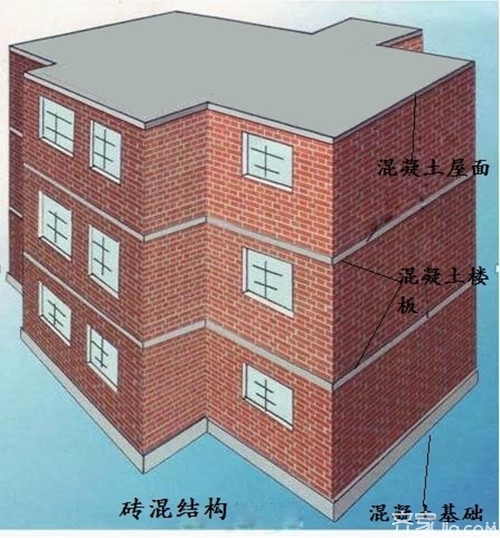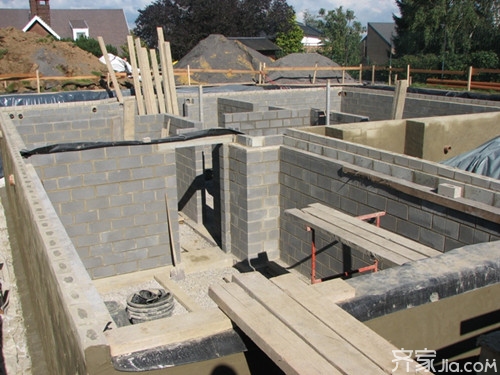People who often deal with architecture know brick and concrete structures! Brick-concrete structure, which is a kind of mixed structure, uses brick walls for load-bearing, and the horizontal load-bearing floors in buildings are all made of reinforced concrete structures, while the vertical load-bearing walls are made of bricks and are suitable for low-rise buildings. Or multi-storey building. Its stability is relatively poor. At present, high-rise buildings that can be seen everywhere in China have gradually given up the use of brick-concrete structures. Perhaps you are not very familiar with the characteristics of brick-concrete structures and the advantages and disadvantages of brick-concrete structures. Don't worry, let's follow me to learn about the relevant knowledge of the characteristics of the brick and concrete structure !

What is a brick-concrete structure
Brick-concrete structure, which is a kind of mixed structure, uses brick walls for load-bearing, and the horizontal load-bearing floors in buildings are all made of reinforced concrete structures, while the vertical load-bearing walls are made of bricks and are suitable for low-rise buildings. Or multi-storey building. Its stability is relatively poor. At present, high-rise buildings that can be seen everywhere in China have gradually given up the use of brick-concrete structures.
At present, new types of building materials continue to emerge, and some walls use composite walls. This material is not very thick, but it can play an important role. On the other hand, the structure of buildings and the way of construction are different, and non-bearing walls play different roles. The major period of the brick-concrete structure was the building of a number of reinforced concrete structures in the 1970s and 1980s. In recent years, a large number of houses have been framed.
Brick and concrete structure features
The brick-concrete structure refers to the use of bricks or masonry for the walls, columns, etc. of the vertical load-bearing structures in the building, and the reinforced concrete structures for the beams, floors, and roof slabs that support the transverse load. In other words, the brick-concrete structure is a structure bearing a small part of reinforced concrete and most of the brick walls. The brick-concrete structure is a kind of mixed structure. It is a mixed structure system composed of brick walls, reinforced concrete beams, columns and plates. It is suitable for buildings with small openings, small rooms, multi-storey or low-rise buildings, which cannot be modified for load-bearing walls, but the frame structure can be modified for most of the walls. Suitable for low or multi-storey buildings. High-rise buildings mostly use reinforced concrete structures. Due to poor stability and waste of resources, China's newly built multi-storey and high-rise buildings have begun to phase out brick-concrete structures.
The load-bearing structure of a frame structure house is a beam, a plate, and a column, and the load-bearing structure of the house of a brick-concrete structure is a floor and a wall. In terms of firmness, theoretically speaking, the firmness of the frame structure can be greater than that of the brick-concrete structure. Therefore, when the brick-concrete structure is used for architectural design, the height cannot exceed 6 layers, and the frame structure can be dozens of layers. However, in the actual construction process, the state stipulated that the building must achieve the earthquake-resistant grades, whether it is a brick or a concrete frame, to achieve this level, and the developers will use the frame structure to build the house, but also not to improve the building's robustness. Increase investment as long as you meet the earthquake rating. In terms of sound insulation effect, the soundproof effect of brick-concrete dwellings is moderate, and the soundproof effect of frame structure depends on the choice of partition materials. Some advanced partition materials have better sound insulation than bricks, while ordinary partition materials such as cement Hollow plates and the like have very poor sound insulation. If you want to renovate the interior space, because most of the walls are not bearing, the frame structure is relatively simple to transform. It can be knocked on the wall. Many brick walls in the brick-concrete structure are load-bearing structures that are not allowed to be dismantled. Only a few non-load-bearing walls can make a fuss. A simple way to distinguish between bearing walls and non-bearing walls is to look at the original structure drawings. Generally, a wall with a wall thickness of 240 mm is load-bearing, and a 120 mm or thinner wall is non-load-bearing, but sometimes it is designed to be flush with a beam or a load-bearing wall. Flat, non-bearing walls will also be 240mm thick.

Brick and concrete structure
The layout of the walls of a brick-concrete structure is as follows:
1, cross-wall bearing. The floor is supported by a cross wall that is parallel to the gable. Commonly used in flat layout of a regular house, dormitories, hotels, office buildings and other small open space buildings. The horizontal wall also serves as a partition wall and a load-bearing wall with a spacing of 3 to 4 m.
2, vertical wall bearing. With the stumbling wall and the vertical wall supporting the floor parallel to the stumbling wall, the opening can be flexibly arranged, but the rigidity of the building is poor, and a large area of ​​doors and windows cannot be opened on the facade.
3, mixed wall loading and unloading. Some use horizontal walls and some use vertical walls to support floors. Mostly used in buildings with complex planes and diversified interior spaces.
4, the brick wall and the inner frame load bearing. The internal beam bearing instead of the wall bearing, the external retaining wall also plays a role in bearing. This arrangement can obtain a larger internal space, the layout of the plane is flexible, but the rigidity of the building is not enough. Often used in larger halls.
5. The bottom layer is a reinforced concrete frame and the upper part is a brick wall bearing structure. It is commonly used on the ground floor for shops, or on the ground floor for public activities. The above space is for residential, office or dormitory buildings.
Advantages and disadvantages of brick-concrete structure
The brick-concrete structure is strictly called the masonry structure. Simply speaking, the advantages of the masonry structure are that the cost is cheap, local materials are used, and the construction difficulty is low; the disadvantage is that the anti-seismic capacity is poor, so it can only cover multiple layers, and the number of layers depends on the local area. The different seismic intensity is different, the height is limited, not including the basement, the floor is built up to 7 floors (Six Degree Area), and the anti-seismic place is made of reinforced masonry structure, the building height can reach 30 meters, pure multi-layer masonry The structure can not achieve the ground floor space, and the layout of the building function is also limited, because the mortar itself is built by mortar, the structure is heavy, so the earthquake resistance is very low, on this basis it is difficult to achieve a large space ( Multilayer). Maximum height can only be done 3600 (multi-layer)

The advantages of brick-concrete structure mainly include:
1Because bricks are the smallest standardized components, they require low construction site and construction technology and can be built into various shapes of walls.
2 It has good durability, chemical stability and atmospheric stability.
3 can save cement, steel and wood, without the template, lower cost.
4 The construction technology and construction equipment are simple.
The sound insulation and thermal insulation of 5 bricks are superior to those of concrete and other wall materials, and thus are most commonly used in residential construction.
Advantages: low cost, local materials (convenient materials), low construction difficulty, high stiffness
Disadvantages: low strength, poor self-resistance capability, limited height, and a reinforced masonry structure that does not resist earthquakes. The structure is self-contained, with poor stability, waste of resources, and environmental protection.
A simple way to judge bearing walls
1. The wall of a standard brick is a load-bearing wall and the air-filled brick is a non-load-bearing wall.
2, knock wall, there is a clear echo of the wall is not a bearing, very stuffy is the bearing wall;
3. The interior wall corners or the pillars protruding from the wall are the frame structures.
4. The use of a rebound tester to determine the compressive strength of concrete is the most accurate method.
Editing summary: Brick-concrete structure houses refer to houses with brick masonry and reinforced concrete beams and plates as load-bearing components. Also refers to stone, concrete blocks and other masonry as load-bearing walls (pillars), other materials such as wood, stone, steel, etc. as beams, plates forming a load-bearing structure of the house. The brick-concrete structure is more suitable for the lower floors and is now gradually combined with modern construction equipment and technology to create a comfortable and good indoor environment.
Living room glass partition wall balcony wall decoration loft bedroom partition wall style sofa wall background wall wall hanging bookshelf brick mix structure characteristics
Aluminum Casting Machinery Parts
Aluminum Casting Machinery Parts,Aluminum Machinery Parts,Agricultural Machinery Parts,Machinery Spare Parts
NINGBO AIKEHAN METAL PRODUCT CO.,LTD , http://www.diecastingsupplier.com